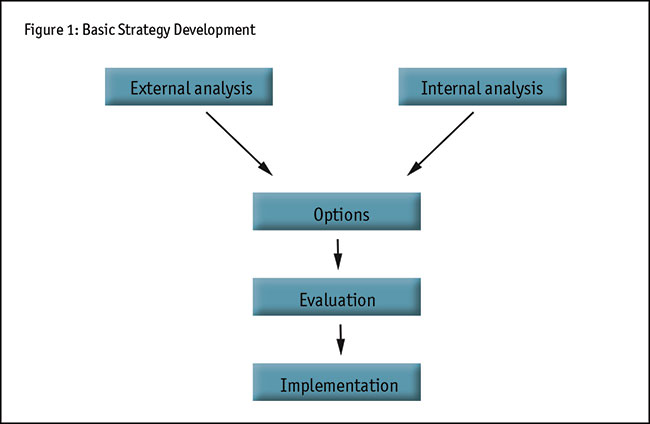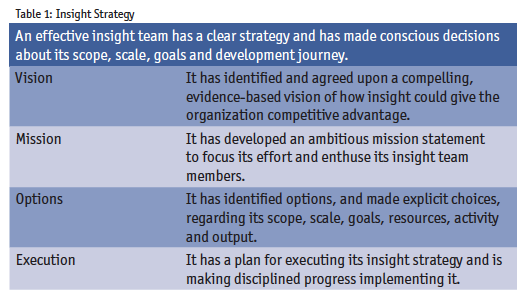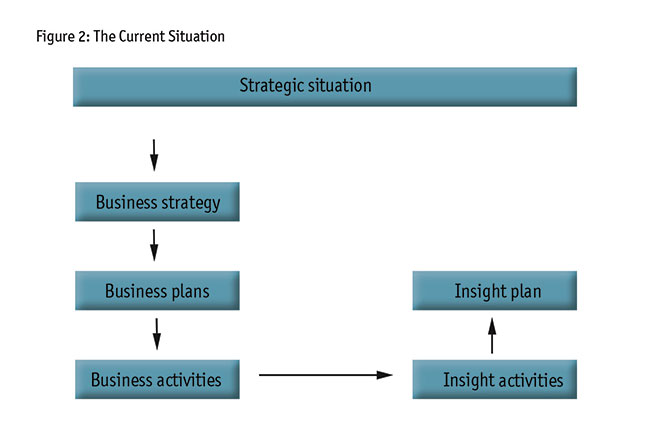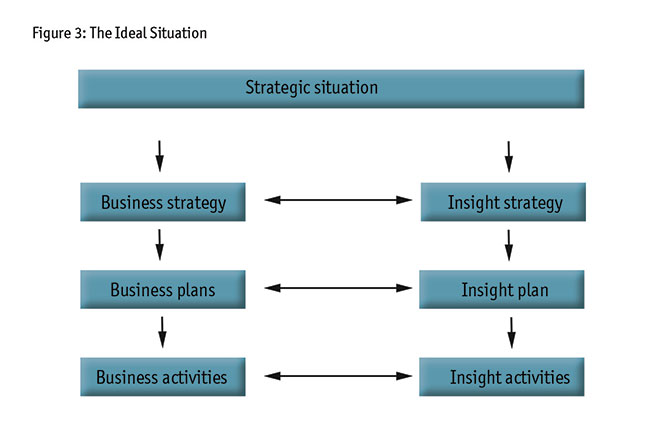Know before you go
Editor's note: James Wycherley is CEO of Insight Management Academy.
 The customer and market insight function has the potential to transform any organization’s performance. However, this won’t happen with great research and rich data alone. If you want to transform your organization, you first have to transform your corporate insight team. The first step in doing that is to develop a comprehensive plan, an insight strategy, something which very few companies have.
The customer and market insight function has the potential to transform any organization’s performance. However, this won’t happen with great research and rich data alone. If you want to transform your organization, you first have to transform your corporate insight team. The first step in doing that is to develop a comprehensive plan, an insight strategy, something which very few companies have.
But what is a strategy? A strategy consists of a description of where you would like to get to and a plan for how you are going to get there.
Classic business strategies will often reference two axes: time and performance. They will define the ultimate goal in terms of business performance and set a date for when they expect to reach it. They will also acknowledge the steps along the way and the potential barriers.
As we shall see later, using the label “strategy” can have disadvantages and insight leaders who have enjoyed careers as market researchers or analysts may feel uncomfortable doing so. If the label gets in the way for you, don’t use it. If, as the insight leader at Transport for London recently suggested, the term sounds “a bit grand,” consider everything that follows in this article as best practice in writing a plan to transform your insight function and the role it plays.
But if you decide to use the word “plan,” make sure that you distinguish this type of planning from the day-to-day exercise of prioritizing activity and allocating resources to projects. These things need to be done but they are no substitute for reflecting more deeply about the role of insight in your company.

Accepted phrases and frameworks
The “strategy” label can also be very useful, because a lot has been written about strategy development and there are accepted phrases and frameworks which insight leaders can adopt. One basic model describes the process usually adopted for corporate strategy development (see Figure 1).
This includes:
- Analysis of the environment in which the business operates, the opportunities and threats which exist in the external market and the organization’s own strengths and weaknesses.
- Identification of options for how the organization could take advantage of the strengths and opportunities and counter the weaknesses and threats.
- An evaluation of the pros and cons of each option, with a resulting recommendation.
- An execution phase during which the strategy will be put into practice.
Our organization, The Insight Management Academy (IMA), was set up in 2004 to support client-side (end-user) research and analysis teams in large organizations. One of our main undertakings is our Insight Forum, which is a group of 40 insight leaders from organizations like eBay, Tesco, Barclays Bank, Nestlé and Asda who share a passion for seeing insight increase its impact.

The IMA has developed a standard approach to describe what should be in an insight strategy and this aligns with the insight strategy territory in the IMA’s Insight Roadmap (see “Time to make a difference,” January 2019 Quirk’s). The same framework is used to benchmark organizations’ current level of progress in developing strategies (see Table 1).
A critical place to start
In the absence of an insight strategy, research and analysis activity tends to be driven by what other departments want. A strategy in itself may not change that, of course, but it is a critical place to start.

Figure 2 shows the situation that exists in many companies:
- The business develops a corporate strategy (sometimes with insight’s input, often without).
- It translates this strategy into a medium-term plan and/or an annual plan, complete with goals and performance objectives.
- The management teams charged with meeting the objectives initiate a lot of corporate activity (frequently hyperactivity and quite possibly at odds with the longer-term strategy or other departments’ goals – but that’s another story!).
- Insight teams are then asked to supply pieces of analysis or market research to support other departments’ activity.
Many insight leaders will produce and update an insight plan but in many cases these documents (or spreadsheets) simply record the requests received or insight projects to which resources have been allocated. They are very important documents and no insight team could survive without them but they are not designed to transform insight’s contribution to the organization, let alone describe how insight might transform the organization’s performance.
The IMA believes that insight leaders need to move their planning “upstream,” ideally developing a plan for insight which either aligns directly with an existing corporate strategy or, better still, examines the data and thinking behind the corporate strategy.

Some business strategies are excellent and some insight leaders (for example those at Suunto in Finland and Sport England in the U.K.) have been intimately involved in their creation at the highest level. For good reason, these insight leaders can develop insight strategies that start where the corporate strategy ends. Other insight leaders are not so fortunate, working in organizations where it is difficult to establish what the overarching strategy is or what is meant by the worthy platitudes pasted on the walls of the corporate headquarters.
Armed with a truly strategic plan for how insight can make a difference, insight leaders can then identify priority questions to address with existing customer and market knowledge or gaps to plug with new market research and analysis. We must engage our key stakeholders at every step, because there is no point in insight pursuing an agenda whose output the rest of the business will ignore. But what is needed is grown-up discussion about existing customer knowledge and new work that could be undertaken, not an order-taking mentality where new research is commissioned without reference to a top-down insight plan.
Define a vision
We will now look at the individual elements in the IMA’s strategy template, starting with the need to define a vision. What is a vision? And how is it different from a mission?
Some textbooks use the terms “vision” and “mission” interchangeably. For our purposes we are going to assume that a vision is a statement or a series of statements which describe the desired destination. In other words, what would we like the future to look like?
A mission, and more specifically a mission statement, is a short expression of the insight team’s purpose, either at this point in time or along the journey towards the future vision.
The IMA’s founder, Steve Wills, believes that it can sometimes be useful to develop two different versions of insight’s vision, which may sound confusing but is an idea that resonates with several IMA members: one for the business – that the CEO and senior execs would look at and buy into – and one for the team, to motivate and engage.
The vision to sell to the rest of the organization will provide an agreed-upon, compelling, evidence-based view of how insight could give the organization competitive advantage. It might also reference the analysis and reflection that led to this view: “battlefield mapping” of external threats and opportunities; understanding how the business creates value; a description of how insight can add to business value; the long-term role for insight in the business.
If needed, a second view could provide inspiration for members of the team and encapsulate what great performance and capability will look like. (Insight Forum members have used phrases like: first port of call; recognized as thought leaders; becoming trusted advisers; revenue/profit generators who proactively identify value; the source of “one version of the truth.”)
The team’s purpose
If the purpose of the vision is to describe what a better version of the future could look like, the mission must capture a sense of the team’s purpose in the near term or along the way. Many teams try to capture the essence of this in a single sentence, a mission statement.
The IMA’s Roadmap says that an effective insight team will have developed an ambitious mission statement to focus its effort and enthuse its insight team members.
Unlike defining a vision, which many insight leaders find quite challenging, writing a mission statement is something many insight team members feel comfortable doing. If the mission statement is to serve as a reference point for the team, it makes sense for at least some of the team members to have a hand in writing it. Moreover, market researchers are often involved in brand development work for their organizations and are familiar with the process of weighing the impact of words carefully and examining them for nuances.
Best practice in writing mission statements is to keep them brief, ideally no more than eight words, and to include a verb, a target population and an outcome that implies something to measure. For example, some years ago one Insight Forum member, Barclays Bank, adopted the mission statement: We will identify value and drive change. The first part of this captures the detective role common to most insight teams; the second part recognizes that identifying opportunities for the business to create more value – for customers and shareholders – was of no use unless insight also succeeded in driving these changes by communicating its knowledge and influencing senior decision makers.
Provide the reference points
Defining a vision of the future and writing a mission statement to capture the purpose of the insight team are key exercises and provide the reference points for other decisions and activity. But they then need to be translated into options and recommendations for key aspects of the insight function, including:
- the scale of the decisions which the insight function will influence;
- the scope and type of activity which the function will undertake;
- the resources required to make a difference; and
- the function’s relationship with other departments and its measure of success.
The IMA refers to these decisions as “options” because it is important to recognize that, even with a vision and mission in place, there will still be choices to make. No organization is going to make an unlimited investment in insight people and research budget, for example, so what are the different trade-offs that could be made and the pros and cons of each?
These issues start to get us into the heart of why insight teams are or are not effective. Many insight leaders may feel they have no say in the headcount they have or that the scope of the team’s activity will remain the way it always has been. It’s necessary to take a critical look at all these assumptions at this stage and ask whether they are compatible with the vision that has been defined.
Executing a plan
Not many organizations can achieve such massive insight transformation programs overnight. A typical timescale might be more like three years, so the final part of the strategy template deals with the process required to bring about the necessary change.
Few insight professionals would regard themselves as change management experts and the difficulty of overcoming barriers, of taking two steps forward and one step back, of sensing that victory is in sight only for a wider reorganization to push it beyond arms’ reach … all this is the typical experience of leaders.
The problem identified in the IMA’s research is that some insight leaders haven’t seen the scale of benefits that can accrue from a strategic plan, while being mindful of the barriers which they will face, and this combination of factors deters them from starting. But this is a classic case of “fail to plan, plan to fail.” Insight is unlikely to suddenly find itself in a position to transform an organization by accident, so any progress is better than none when the prize could be so great.
The famous Mikhail Gorbachev quote – “If not me, who? And if not now, when?” – seems pertinent. Unless insight leaders believe there is someone better-placed than them in the organization to transform insight, they have a responsibility to take on the challenge. And as there will always be more urgent things to do but rarely something so important, the time to start is now.
Research and reflection
A lot of the strategy development process for insight, as for an organization, involves research and reflection. It is important to have a written strategy but, to reassure you, it doesn’t need to be enormously long or complex, providing it covers:
- the opportunity for your organization to improve if driven by insight;
- your vision for the role insight needs to play to achieve this;
- a mission statement for your insight function;
- specific options and recommendations for how the function will operate; and
- an execution plan covering one-to-three years, with shorter-term milestones.
Why is it so important to write it down? There are a number of reasons, including:
- The act of writing forces us to be more specific than we would otherwise be.
- It crystalizes our ideas and ensures they are not lost.
- It provides a document we can show others (but bear in mind that different versions may be appropriate for senior executives, other stakeholders and team members).
Change their plans
A number of IMA members have questioned their ability to develop a successful insight strategy and the wisdom of documenting their plans, when their organizations are prone to reorganizing, which often ends up changing their corporate plans and objectives.
There is nothing an insight leader can do about wider corporate change; it’s a fact of life we have all had to adapt to. But wider corporate change does not invalidate the thinking which you do on your insight strategy, nor does it necessarily mean you have to change large parts of it.
To develop your strategies, the first step for insight leaders is to look beyond your organization to the wider market. Then, look at your organization in its market and, later, the decision-making environment within which insight operates. A key reason for this is to focus on the truly strategic situation first, the piece which is least likely to change when a company recruits a new CEO or announces a reorganization.
Rapid change and reorganization shouldn’t mean a strategy becomes invalid. Rather, your vision and mission should remain solid and your need to build capabilities and processes are likely to be the same, so much of your strategy should be relatively static. But your strategy should explicitly predict and acknowledge likely change and include content on how to handle it.
Never getting around to it
Earlier in this article we urged insight leaders to avoid putting off their thinking on strategic plans. There will always be something that appears more urgent; waiting for a quiet moment is a recipe for never getting around to it and allowing the present situation to continue. It’s unlikely that your board of directors will wake up tomorrow and present you with a golden opportunity.
After talking with the members of the Insight Forum and Insight Network, it’s clear there are some notable patterns/situations that provide the impetus for strategy development:
Insight leader new in role. When an insight leader is new in their role, that’s a natural point at which to review what an insight function is for and what it does or does not do.
Pressure from senior executive. Sometimes there is a push from above for insight to have more impact – for example, if there is a new CEO who is keen to see the organization be more insight-led – and that can prompt a more considered insight strategy.
Insight leader dislikes status quo. Sometimes it’s the insight leader or team themselves who feels the need for things to be clearer or better.
Significant organizational change. Sometimes a major shake-up is what prompts the need for an insight strategy.
Insight leader faces a strategic choice. Sometimes the insight function needs to make a particular strategic choice, for example about its activity or relationship with another department.
A mind-set: How can you manage without one? In other cases, the need for an insight strategy is so well-established that the insight leader and/or their team would feel naked without one.
Checklist for your strategy
To wrap up, here is a short summary of the key points made in this guide, a kind of checklist for developing your insight strategy:
- A strategy is a description of where you would like to get to and how you are going to get there. It begins with an analysis of the current situation and a vision for how things could be very different in the future.
- Many organizations, and insight teams, adopt short mission statements to describe their activity and its intended impact. A vision will never be realized unless it can be translated into some practical options and recommendations for change.
- Change rarely happens overnight so it is good practice to write a one-to-three-year implementation plan showing how you plan to execute the strategy.
- Insight leaders are most likely to write strategies when they are new in role or challenged by an incoming senior executive but if your organization does not have a strategy for how insight can transform the company’s performance, there is no time like the present to write one.
- Unless the insight leader thinks there is someone better-placed to develop the strategy than them, it is their responsibility to take the lead.
